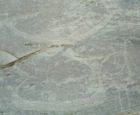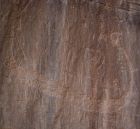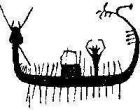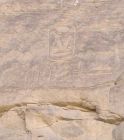Kanais Temple & Nearby Rock-Art
Most of the survey expeditions started off leaving the Edfu road and turning into the desert with a first stop at Kanais. When the EDS started the cultivation only reached a couple of miles from the Nile. But now irrigation works have extended this. Whereas previously there was a considerable space of desert to the police post and then Kanais Temple, now the cultivation has spread nearly up to it. From the Nile the Wadi Abbad leads into Wadi Kanais-and in turn into wadi Baramiya. Kanais Temple is in the Wadi Kanais (although in Weigall and Rohl it is marked as being in Wadi Abbad.)
Thirty-five miles along the Edfu-Mersa Alam road is Seti I's Temple at Kanais. A Roman well and fortlet stand here too. The temple is cut into the cliff face, a rare occurrence in Egypt. The portico still has a lot of colour on its images, but the interior is inaccessible as the entrance has been blocked up. According to Seti's inscription:
'His Majesty inspected the hill country as far as the region of the mountains, for his heart desired to see the mines from which the gold is brought. He said, "How evil is the way without water. It is so for a traveller whose mouth is parched. How shall his throat be cooled? How evil is the way without water. For the lowland is far away and the highland is vast. The thirsty man cries out against a fatal country. I will make for them a supply for preserving them alive, so they will thank the god in my name in after years." Then this place was built in the great name of Seti and the water flowed in great plenty. Never was the like of it made by any king, save by the King Seti, the Good Shepherd who preserves his soldiers alive, the father and mother of all. Men say from mouth to mouth, "O Ammon, give to him eternity, for he has opened for us the road to march on. We proceed. We are safe. We arrive and are preserved alive. The difficult way which is in our memory has become a good way. He has caused the mining of the gold to be easy. He has dug for water in the desert far from men for the supply of every traveller who traverses the highlands." (from Weigall, 1909)
The petroglyphs are to the left of the temple, high on a cliff face and on two rocks to the front and further left.
Feel free to browse through my photos below. You can click on any image thumbnail to expand it.































